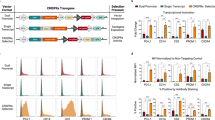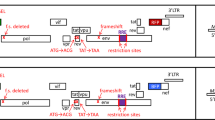Abstract
We present a method for fast and efficient trapping of genes whose transcription is regulated by exogenous stimuli. We constructed a promoterless retroviral vector transducing a green fluorescent protein1–nitroreductase2 (GFNR) fusion protein downstream from a splice acceptor site. Flow cytometric analysis of the infected population allows identification and sorting of cells in which the trap is integrated downstream from an active promoter. Conversely, the nitroreductase (NTR) moiety allows pharmacological selection against constitutive GFNR expression. Using hepatocyte growth factor (HGF) stimulation of liver cells3 combined with either positive or negative selection, we recovered cell populations carrying traps in induced or suppressed genes, respectively. Several distinct responsive clones were isolated, and regulated expression of the trapped gene was confirmed at the RNA level. Positive and negative selection can be calibrated to recover traps in genes showing different levels of basal expression or transcriptional regulation. The flexibility and efficiency of the GFNR-based trap screening procedure make it suitable for wide surveys of transcriptionally regulated genes.
This is a preview of subscription content, access via your institution
Access options
Subscribe to this journal
Receive 12 print issues and online access
$209.00 per year
only $17.42 per issue
Buy this article
- Purchase on Springer Link
- Instant access to full article PDF
Prices may be subject to local taxes which are calculated during checkout



Similar content being viewed by others
References
Li, X. et al. Generation of destabilized green fluorescent protein as a transcription reporter. J. Biol. Chem. 273, 34970–34975 (1998).
Bridgewater, J.A. et al. Expression of the bacterial nitroreductase enzyme in mammalian cells renders them selectively sensitive to killing by the prodrug CB1954. Eur. J. Cancer 31, 2362–2370 (1995).
Medico, E. et al. The tyrosine kinase receptors Ron and Sea control "scattering" and morphogenesis of liver progenitor cells in vitro. Mol. Biol. Cell 7, 495–504 (1996).
Brown, S.D. & Nolan, P.M. Mouse mutagenesis-systematic studies of mammalian gene function. Hum. Mol. Genet. 7, 1627–1633 (1998).
Forrester, L.M. et al. An induction gene trap screen in embryonic stem cells: identification of genes that respond to retinoic acid in vitro. Proc. Natl. Acad. Sci. USA 93, 1677–1682 (1996).
Gogos, J.A., Lowry, W. & Karayiorgou, M. Selection for retroviral insertions into regulated genes. J. Virol. 71, 1644–1650 (1997).
Whitney, M. et al. A genome-wide functional assay of signal transduction in living mammalian cells. Nat. Biotechnol. 16, 1329–1333 (1998).
Akiyama, N., Matsuo, Y., Sai, H., Noda, M. & Kizaka-Kondoh, S. Identification of a series of transforming growth factor beta-responsive genes by retrovirus-mediated gene trap screening. Mol. Cell. Biol. 20, 3266–3273 (2000).
Komada, M., McLean, D.J., Griswold, M.D., Russell, L.D. & Soriano, P. E-MAP-115, encoding a microtubule-associated protein, is a retinoic acid-inducible gene required for spermatogenesis. Genes Dev. 14, 1332–1342 (2000).
Baker, R.K. et al. In vitro preselection of gene-trapped embryonic stem cell clones for characterizing novel developmentally regulated genes in the mouse. Dev. Biol. 185, 201–214 (1997).
Bonaldo, P., Chowdhury, K., Stoykova, A., Torres, M. & Gruss, P. Efficient gene trap screening for novel developmental genes using IRES beta geo vector and in vitro preselection. Exp. Cell Res. 244, 125–136 (1998).
Iyer, V.R. et al. The transcriptional program in the response of human fibroblasts to serum. Science 283, 83–87 (1999).
Velculescu, V.E., Zhang, L., Vogelstein, B. & Kinzler, K.W. Serial analysis of gene expression. Science 270, 484–487 (1995).
Bridgewater, J.A., Knox, R.J., Pitts, J.D., Collins, M.K. & Springer, C.J. The bystander effect of the ntroreductase/CB1954 enzyme/prodrug system is due to a cell-permeable metabolite. Hum. Gene Ther. 8, 709–717 (1997).
Markowitz, D., Goff, S. & Bank, A. A safe packaging line for gene transfer: separating viral genes on two different plasmids. J. Virol. 62, 1120–1124 (1988).
Coller, H.A. et al. Expression analysis with oligonucleotide microarrays reveals that MYC regulates genes involved in growth, cell cycle, signaling, and adhesion. Proc. Natl. Acad. Sci. USA 28, 3260–3265 (2000).
Ishida, Y. & Leder, P. RET: a poly A-trap retrovirus vector for reversible disruption and expression monitoring of genes in living cells. Nucleic Acids Res. 27, e35 (1999).
Ben-Porath, I., Yanuka, O. & Benvenisty, N. The tmp gene, encoding a membrane protein, is a c-Myc target with a tumorigenic activity. Mol. Cell. Biol. 19, 3529–3539 (1999).
Song, H.J. et al. Mouse Sprr2 genes: a clustered family of genes showing differential expression in epithelial tissues. Genomics 55, 28–42 (1999).
Desiderio, M.A., Pogliaghi, G. & Dansi, P. Hepatocyte growth factor-induced expression of ornithine decarboxylase, c-met, and c-myc is differently affected by protein kinase inhibitors in human hepatoma cells HepG2. Exp. Cell Res. 242, 401–409 (1998).
Ochman, H., Gerber, A.S. & Hartl, D.L. Genetic applications of an inverse polymerase chain reaction. Genetics 120, 621–623 (1988).
Friedrich, G. & Soriano, P. Promoter traps in embryonic stem cells: a genetic screen to identify and mutate developmental genes in mice. Genes Dev. 5, 1513–1523 (1991).
Soriano, P., Friedrich, G. & Lawinger, P. Promoter interactions in retrovirus vectors introduced into fibroblasts and embryonic stem cells. J. Virol. 65, 2314–2319 (1991).
Naldini, L. et al. Biological activation of pro-HGF (hepatocyte growth factor) by urokinase is controlled by a stoichiometric reaction. J. Biol. Chem. 270, 603–611 (1995).
Acknowledgements
We gratefully acknowledge Richard Palmiter (University of Washington–Seattle) for providing NTR cDNA. Thanks to Giuseppe Basso, Massimo Geuna, and the Fred Hutchinson Cancer Research Center (FHCRC) flow cytometry resource staff for their help with flow cytometry and cell sorting. We thank Weisheng Chen, Jon Cooper, Guy Hamilton, Jeff Hildebrand, and Masayuki Komada for critical comments on the manuscript. During his stay at FHCRC, E.M. was supported by a short-term fellowship from Fondazione Italiana per la Ricerca sul Cancro (FIRC). This research was supported by grants HD24875 and HD25326 from NIH to P.S., and by grants from the Armenise-Harvard Foundation for Advanced Scientific Research and Associazione Italiana per la Ricerca sul Cancro (AIRC) to P.M.C.
Author information
Authors and Affiliations
Corresponding author
Rights and permissions
About this article
Cite this article
Medico, E., Gambarotta, G., Gentile, A. et al. A gene trap vector system for identifying transcriptionally responsive genes. Nat Biotechnol 19, 579–582 (2001). https://doi.org/10.1038/89343
Received:
Accepted:
Issue Date:
DOI: https://doi.org/10.1038/89343
This article is cited by
-
NTR 2.0: a rationally engineered prodrug-converting enzyme with substantially enhanced efficacy for targeted cell ablation
Nature Methods (2022)
-
A modified gene trap approach for improved high-throughput cancer drug discovery
Oncogene (2018)
-
Identifying genes preferentially expressed in undifferentiated embryonic stem cells
BMC Cell Biology (2007)
-
HGF induces fibronectin matrix synthesis in melanoma cells through MAP kinase-dependent signaling pathway and induction of Egr-1
Oncogene (2005)
-
Insertional mutagenesis in mice: new perspectives and tools
Nature Reviews Genetics (2005)



